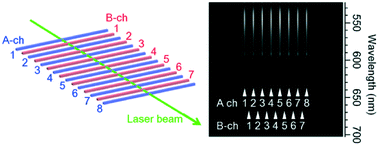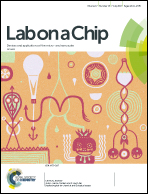A simple and highly sensitive spectroscopic fluorescence-detection system for multi-channel plastic-microchip electrophoresis based on side-entry laser-beam zigzag irradiation
Abstract
A five-color fluorescence-detection system for eight-channel plastic-microchip electrophoresis was developed. In the eight channels (with effective electrophoretic lengths of 10 cm), single-stranded DNA fragments were separated (with single-base resolution up to 300 bases within 10 min), and seventeen-loci STR genotyping for forensic human identification was successfully demonstrated. In the system, a side-entry laser beam is passed through the eight channels (eight A channels), with alternately arrayed seven sacrificial channels (seven B channels), by a technique called “side-entry laser-beam zigzag irradiation.” Laser-induced fluorescence from the eight A channels and Raman-scattered light from the seven B channels are then simultaneously, uniformly, and spectroscopically detected, in the direction perpendicular to the channel array plane, through a transmission grating and a CCD camera. The system is therefore simple and highly sensitive. Because the microchip is fabricated by plastic-injection molding, it is inexpensive and disposable and thus suitable for actual use in various fields.

- This article is part of the themed collection: Lab on a Chip Recent Open Access Articles

 Please wait while we load your content...
Please wait while we load your content...